Lessons from Shackleton's Leadership Style for Contemporary Business Organizations
VerifiedAdded on 2023/06/10
|8
|2308
|233
AI Summary
This case study discusses the important lessons from Shackleton's leadership style which could help in a crisis in context of contemporary business organisation. It further critically analyses an organisational situation by drawing the schools of leadership. The report makes recommendations for improving performance.
Contribute Materials
Your contribution can guide someone’s learning journey. Share your
documents today.
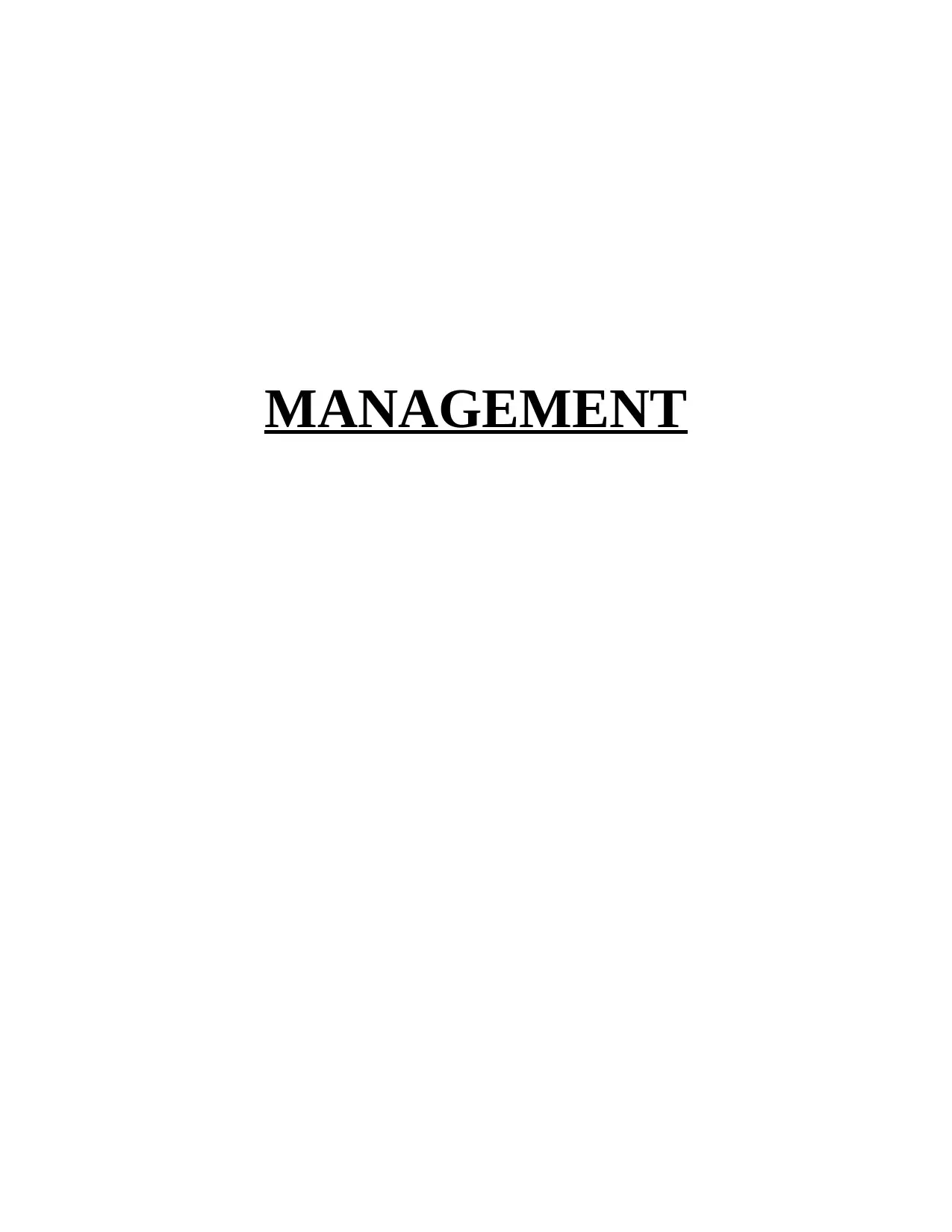
MANAGEMENT
Secure Best Marks with AI Grader
Need help grading? Try our AI Grader for instant feedback on your assignments.
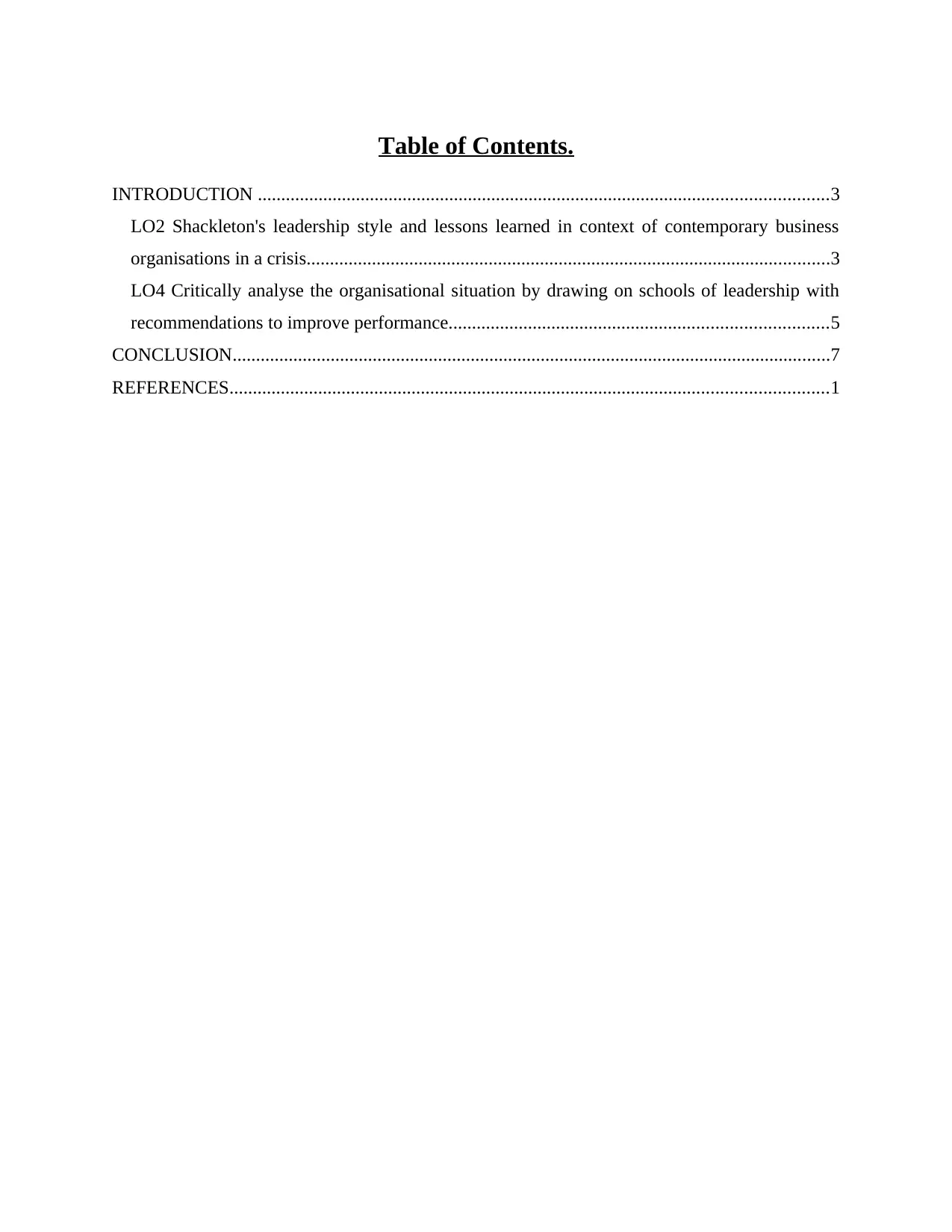
Table of Contents.
INTRODUCTION ..........................................................................................................................3
LO2 Shackleton's leadership style and lessons learned in context of contemporary business
organisations in a crisis................................................................................................................3
LO4 Critically analyse the organisational situation by drawing on schools of leadership with
recommendations to improve performance.................................................................................5
CONCLUSION................................................................................................................................7
REFERENCES................................................................................................................................1
INTRODUCTION ..........................................................................................................................3
LO2 Shackleton's leadership style and lessons learned in context of contemporary business
organisations in a crisis................................................................................................................3
LO4 Critically analyse the organisational situation by drawing on schools of leadership with
recommendations to improve performance.................................................................................5
CONCLUSION................................................................................................................................7
REFERENCES................................................................................................................................1
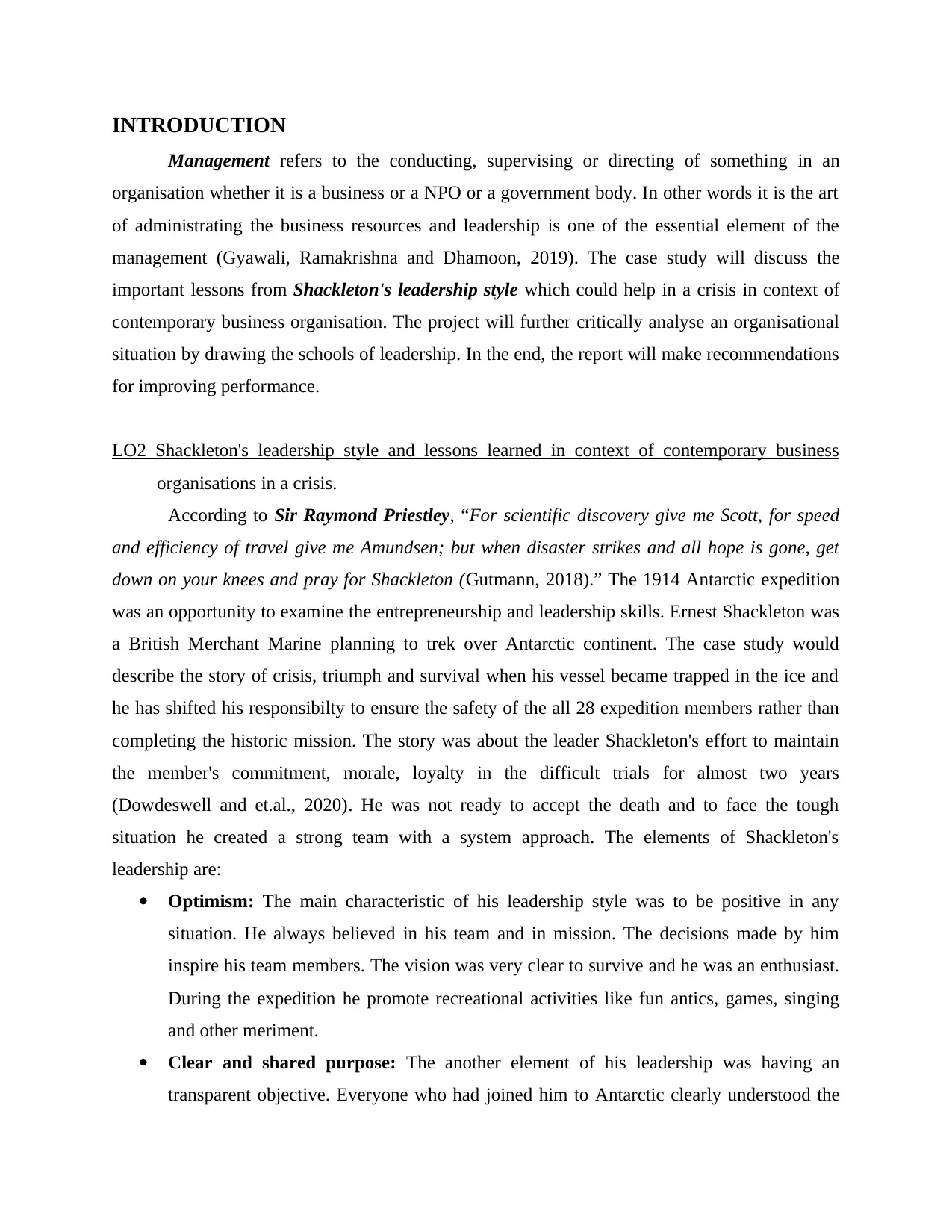
INTRODUCTION
Management refers to the conducting, supervising or directing of something in an
organisation whether it is a business or a NPO or a government body. In other words it is the art
of administrating the business resources and leadership is one of the essential element of the
management (Gyawali, Ramakrishna and Dhamoon, 2019). The case study will discuss the
important lessons from Shackleton's leadership style which could help in a crisis in context of
contemporary business organisation. The project will further critically analyse an organisational
situation by drawing the schools of leadership. In the end, the report will make recommendations
for improving performance.
LO2 Shackleton's leadership style and lessons learned in context of contemporary business
organisations in a crisis.
According to Sir Raymond Priestley, “For scientific discovery give me Scott, for speed
and efficiency of travel give me Amundsen; but when disaster strikes and all hope is gone, get
down on your knees and pray for Shackleton (Gutmann, 2018).” The 1914 Antarctic expedition
was an opportunity to examine the entrepreneurship and leadership skills. Ernest Shackleton was
a British Merchant Marine planning to trek over Antarctic continent. The case study would
describe the story of crisis, triumph and survival when his vessel became trapped in the ice and
he has shifted his responsibilty to ensure the safety of the all 28 expedition members rather than
completing the historic mission. The story was about the leader Shackleton's effort to maintain
the member's commitment, morale, loyalty in the difficult trials for almost two years
(Dowdeswell and et.al., 2020). He was not ready to accept the death and to face the tough
situation he created a strong team with a system approach. The elements of Shackleton's
leadership are:
Optimism: The main characteristic of his leadership style was to be positive in any
situation. He always believed in his team and in mission. The decisions made by him
inspire his team members. The vision was very clear to survive and he was an enthusiast.
During the expedition he promote recreational activities like fun antics, games, singing
and other meriment.
Clear and shared purpose: The another element of his leadership was having an
transparent objective. Everyone who had joined him to Antarctic clearly understood the
Management refers to the conducting, supervising or directing of something in an
organisation whether it is a business or a NPO or a government body. In other words it is the art
of administrating the business resources and leadership is one of the essential element of the
management (Gyawali, Ramakrishna and Dhamoon, 2019). The case study will discuss the
important lessons from Shackleton's leadership style which could help in a crisis in context of
contemporary business organisation. The project will further critically analyse an organisational
situation by drawing the schools of leadership. In the end, the report will make recommendations
for improving performance.
LO2 Shackleton's leadership style and lessons learned in context of contemporary business
organisations in a crisis.
According to Sir Raymond Priestley, “For scientific discovery give me Scott, for speed
and efficiency of travel give me Amundsen; but when disaster strikes and all hope is gone, get
down on your knees and pray for Shackleton (Gutmann, 2018).” The 1914 Antarctic expedition
was an opportunity to examine the entrepreneurship and leadership skills. Ernest Shackleton was
a British Merchant Marine planning to trek over Antarctic continent. The case study would
describe the story of crisis, triumph and survival when his vessel became trapped in the ice and
he has shifted his responsibilty to ensure the safety of the all 28 expedition members rather than
completing the historic mission. The story was about the leader Shackleton's effort to maintain
the member's commitment, morale, loyalty in the difficult trials for almost two years
(Dowdeswell and et.al., 2020). He was not ready to accept the death and to face the tough
situation he created a strong team with a system approach. The elements of Shackleton's
leadership are:
Optimism: The main characteristic of his leadership style was to be positive in any
situation. He always believed in his team and in mission. The decisions made by him
inspire his team members. The vision was very clear to survive and he was an enthusiast.
During the expedition he promote recreational activities like fun antics, games, singing
and other meriment.
Clear and shared purpose: The another element of his leadership was having an
transparent objective. Everyone who had joined him to Antarctic clearly understood the
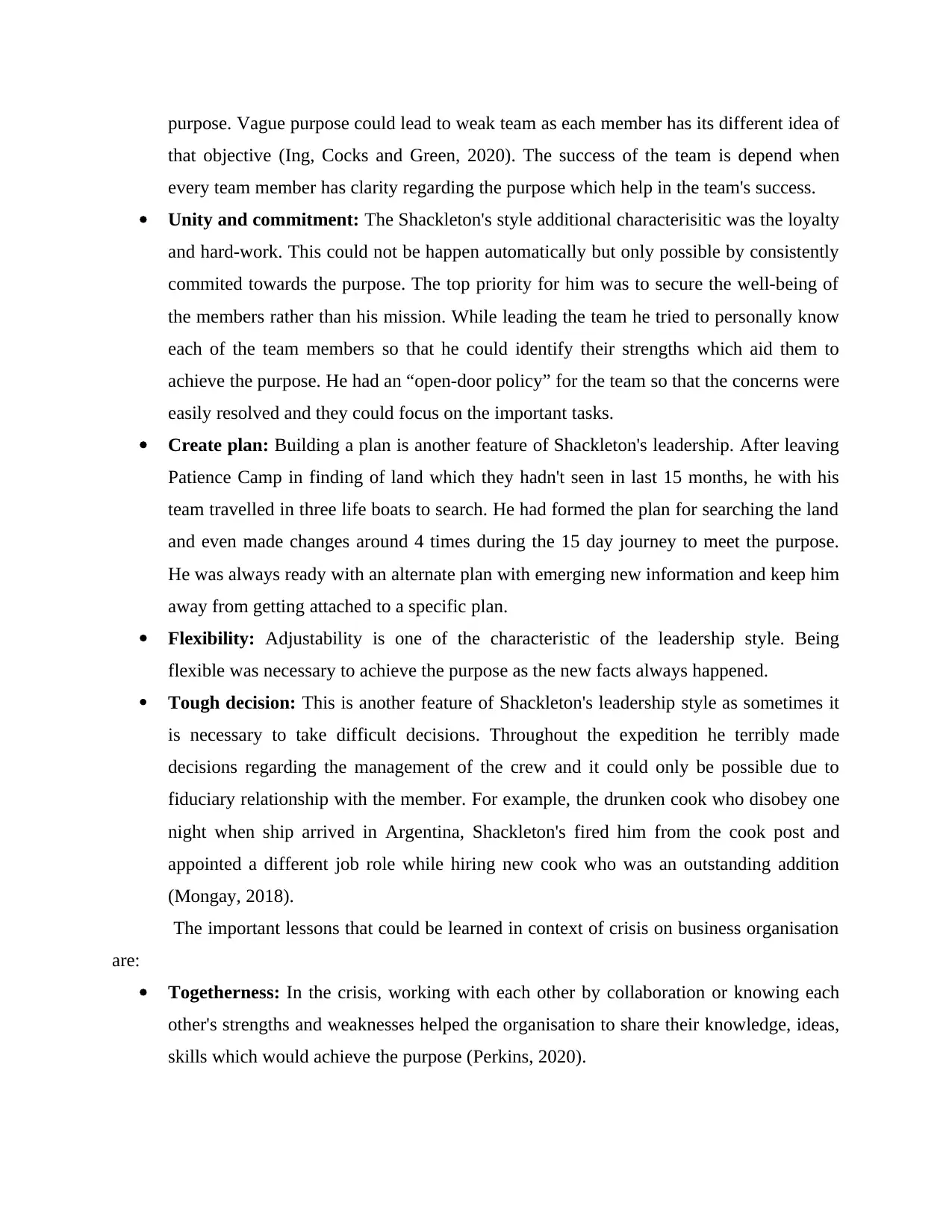
purpose. Vague purpose could lead to weak team as each member has its different idea of
that objective (Ing, Cocks and Green, 2020). The success of the team is depend when
every team member has clarity regarding the purpose which help in the team's success.
Unity and commitment: The Shackleton's style additional characterisitic was the loyalty
and hard-work. This could not be happen automatically but only possible by consistently
commited towards the purpose. The top priority for him was to secure the well-being of
the members rather than his mission. While leading the team he tried to personally know
each of the team members so that he could identify their strengths which aid them to
achieve the purpose. He had an “open-door policy” for the team so that the concerns were
easily resolved and they could focus on the important tasks.
Create plan: Building a plan is another feature of Shackleton's leadership. After leaving
Patience Camp in finding of land which they hadn't seen in last 15 months, he with his
team travelled in three life boats to search. He had formed the plan for searching the land
and even made changes around 4 times during the 15 day journey to meet the purpose.
He was always ready with an alternate plan with emerging new information and keep him
away from getting attached to a specific plan.
Flexibility: Adjustability is one of the characteristic of the leadership style. Being
flexible was necessary to achieve the purpose as the new facts always happened.
Tough decision: This is another feature of Shackleton's leadership style as sometimes it
is necessary to take difficult decisions. Throughout the expedition he terribly made
decisions regarding the management of the crew and it could only be possible due to
fiduciary relationship with the member. For example, the drunken cook who disobey one
night when ship arrived in Argentina, Shackleton's fired him from the cook post and
appointed a different job role while hiring new cook who was an outstanding addition
(Mongay, 2018).
The important lessons that could be learned in context of crisis on business organisation
are:
Togetherness: In the crisis, working with each other by collaboration or knowing each
other's strengths and weaknesses helped the organisation to share their knowledge, ideas,
skills which would achieve the purpose (Perkins, 2020).
that objective (Ing, Cocks and Green, 2020). The success of the team is depend when
every team member has clarity regarding the purpose which help in the team's success.
Unity and commitment: The Shackleton's style additional characterisitic was the loyalty
and hard-work. This could not be happen automatically but only possible by consistently
commited towards the purpose. The top priority for him was to secure the well-being of
the members rather than his mission. While leading the team he tried to personally know
each of the team members so that he could identify their strengths which aid them to
achieve the purpose. He had an “open-door policy” for the team so that the concerns were
easily resolved and they could focus on the important tasks.
Create plan: Building a plan is another feature of Shackleton's leadership. After leaving
Patience Camp in finding of land which they hadn't seen in last 15 months, he with his
team travelled in three life boats to search. He had formed the plan for searching the land
and even made changes around 4 times during the 15 day journey to meet the purpose.
He was always ready with an alternate plan with emerging new information and keep him
away from getting attached to a specific plan.
Flexibility: Adjustability is one of the characteristic of the leadership style. Being
flexible was necessary to achieve the purpose as the new facts always happened.
Tough decision: This is another feature of Shackleton's leadership style as sometimes it
is necessary to take difficult decisions. Throughout the expedition he terribly made
decisions regarding the management of the crew and it could only be possible due to
fiduciary relationship with the member. For example, the drunken cook who disobey one
night when ship arrived in Argentina, Shackleton's fired him from the cook post and
appointed a different job role while hiring new cook who was an outstanding addition
(Mongay, 2018).
The important lessons that could be learned in context of crisis on business organisation
are:
Togetherness: In the crisis, working with each other by collaboration or knowing each
other's strengths and weaknesses helped the organisation to share their knowledge, ideas,
skills which would achieve the purpose (Perkins, 2020).
Secure Best Marks with AI Grader
Need help grading? Try our AI Grader for instant feedback on your assignments.
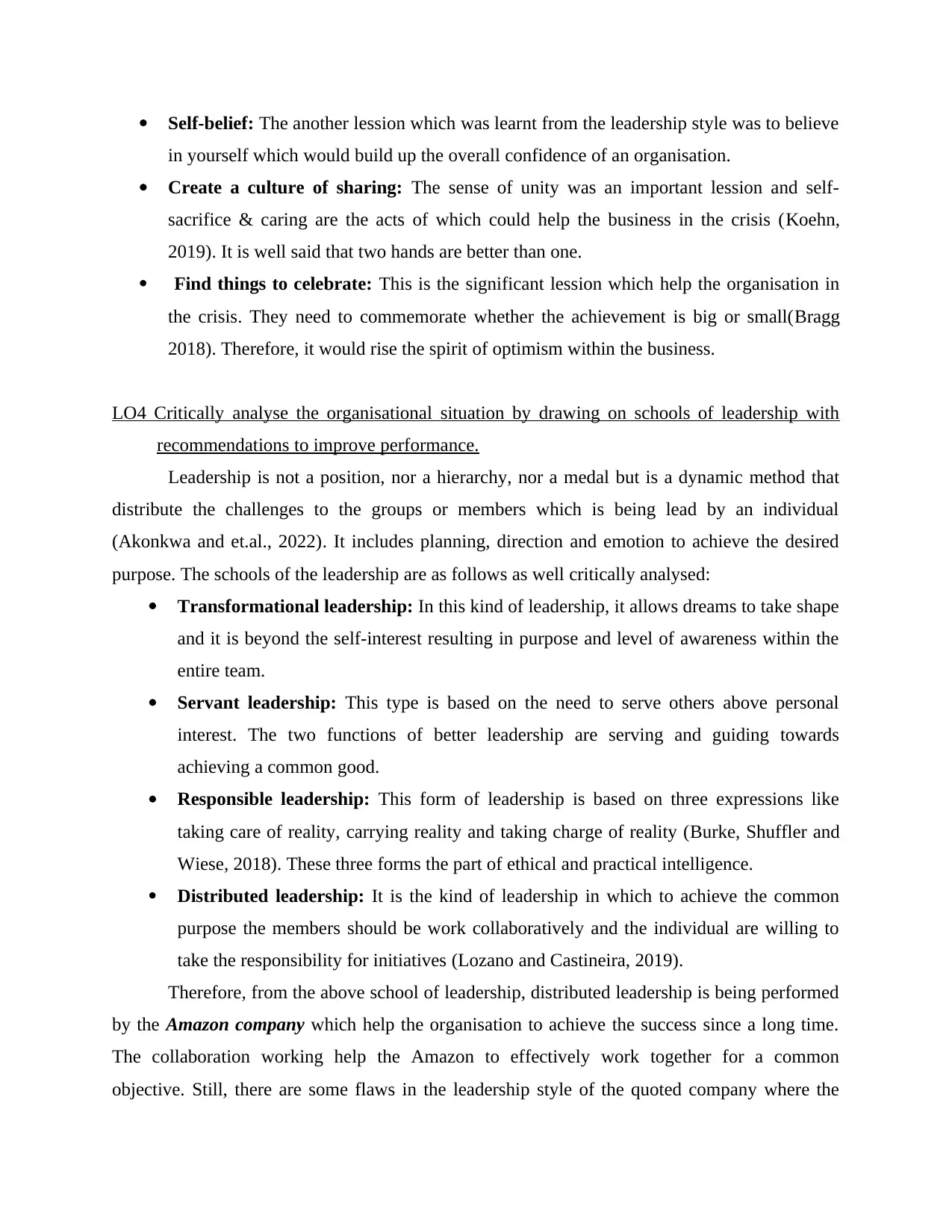
Self-belief: The another lession which was learnt from the leadership style was to believe
in yourself which would build up the overall confidence of an organisation.
Create a culture of sharing: The sense of unity was an important lession and self-
sacrifice & caring are the acts of which could help the business in the crisis (Koehn,
2019). It is well said that two hands are better than one.
Find things to celebrate: This is the significant lession which help the organisation in
the crisis. They need to commemorate whether the achievement is big or small(Bragg
2018). Therefore, it would rise the spirit of optimism within the business.
LO4 Critically analyse the organisational situation by drawing on schools of leadership with
recommendations to improve performance.
Leadership is not a position, nor a hierarchy, nor a medal but is a dynamic method that
distribute the challenges to the groups or members which is being lead by an individual
(Akonkwa and et.al., 2022). It includes planning, direction and emotion to achieve the desired
purpose. The schools of the leadership are as follows as well critically analysed:
Transformational leadership: In this kind of leadership, it allows dreams to take shape
and it is beyond the self-interest resulting in purpose and level of awareness within the
entire team.
Servant leadership: This type is based on the need to serve others above personal
interest. The two functions of better leadership are serving and guiding towards
achieving a common good.
Responsible leadership: This form of leadership is based on three expressions like
taking care of reality, carrying reality and taking charge of reality (Burke, Shuffler and
Wiese, 2018). These three forms the part of ethical and practical intelligence.
Distributed leadership: It is the kind of leadership in which to achieve the common
purpose the members should be work collaboratively and the individual are willing to
take the responsibility for initiatives (Lozano and Castineira, 2019).
Therefore, from the above school of leadership, distributed leadership is being performed
by the Amazon company which help the organisation to achieve the success since a long time.
The collaboration working help the Amazon to effectively work together for a common
objective. Still, there are some flaws in the leadership style of the quoted company where the
in yourself which would build up the overall confidence of an organisation.
Create a culture of sharing: The sense of unity was an important lession and self-
sacrifice & caring are the acts of which could help the business in the crisis (Koehn,
2019). It is well said that two hands are better than one.
Find things to celebrate: This is the significant lession which help the organisation in
the crisis. They need to commemorate whether the achievement is big or small(Bragg
2018). Therefore, it would rise the spirit of optimism within the business.
LO4 Critically analyse the organisational situation by drawing on schools of leadership with
recommendations to improve performance.
Leadership is not a position, nor a hierarchy, nor a medal but is a dynamic method that
distribute the challenges to the groups or members which is being lead by an individual
(Akonkwa and et.al., 2022). It includes planning, direction and emotion to achieve the desired
purpose. The schools of the leadership are as follows as well critically analysed:
Transformational leadership: In this kind of leadership, it allows dreams to take shape
and it is beyond the self-interest resulting in purpose and level of awareness within the
entire team.
Servant leadership: This type is based on the need to serve others above personal
interest. The two functions of better leadership are serving and guiding towards
achieving a common good.
Responsible leadership: This form of leadership is based on three expressions like
taking care of reality, carrying reality and taking charge of reality (Burke, Shuffler and
Wiese, 2018). These three forms the part of ethical and practical intelligence.
Distributed leadership: It is the kind of leadership in which to achieve the common
purpose the members should be work collaboratively and the individual are willing to
take the responsibility for initiatives (Lozano and Castineira, 2019).
Therefore, from the above school of leadership, distributed leadership is being performed
by the Amazon company which help the organisation to achieve the success since a long time.
The collaboration working help the Amazon to effectively work together for a common
objective. Still, there are some flaws in the leadership style of the quoted company where the
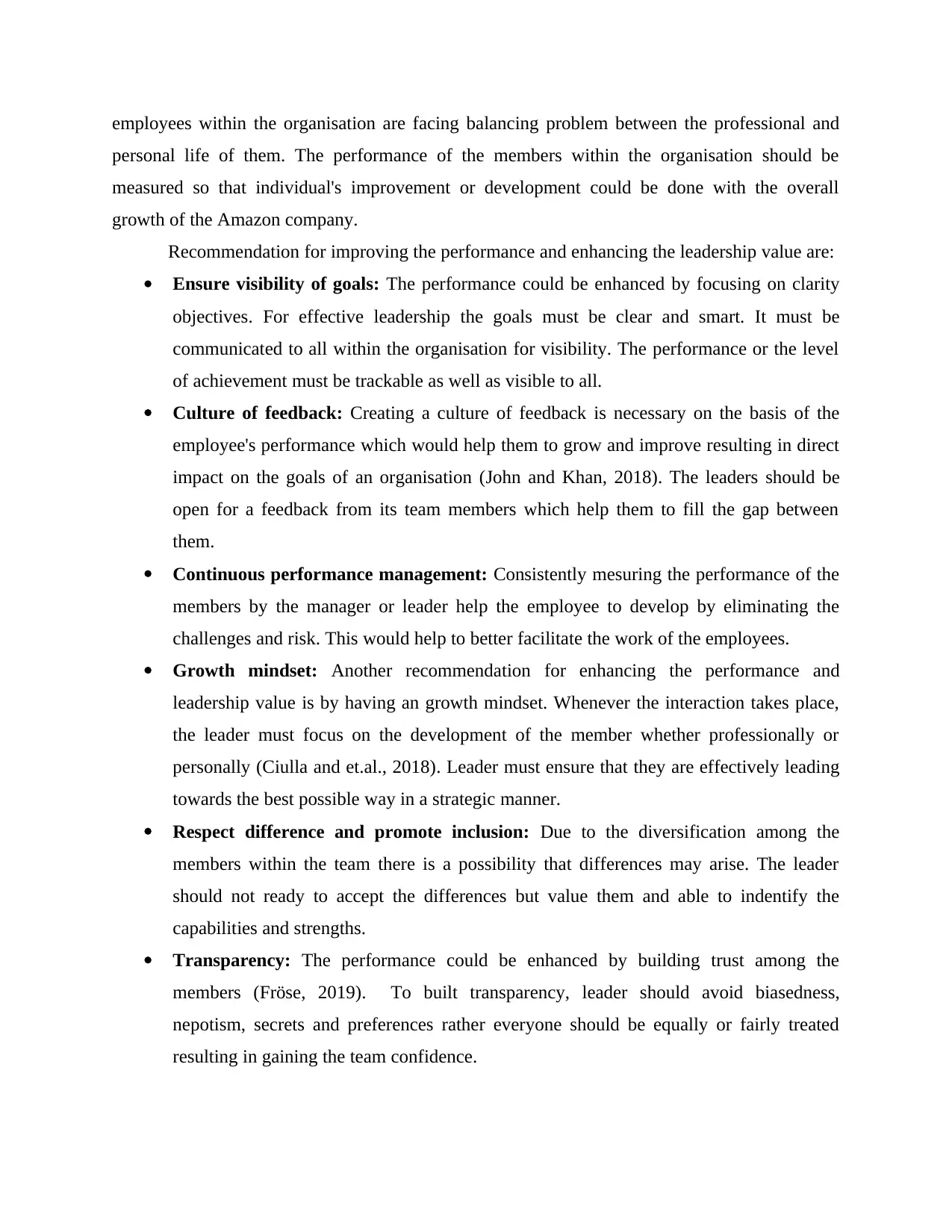
employees within the organisation are facing balancing problem between the professional and
personal life of them. The performance of the members within the organisation should be
measured so that individual's improvement or development could be done with the overall
growth of the Amazon company.
Recommendation for improving the performance and enhancing the leadership value are:
Ensure visibility of goals: The performance could be enhanced by focusing on clarity
objectives. For effective leadership the goals must be clear and smart. It must be
communicated to all within the organisation for visibility. The performance or the level
of achievement must be trackable as well as visible to all.
Culture of feedback: Creating a culture of feedback is necessary on the basis of the
employee's performance which would help them to grow and improve resulting in direct
impact on the goals of an organisation (John and Khan, 2018). The leaders should be
open for a feedback from its team members which help them to fill the gap between
them.
Continuous performance management: Consistently mesuring the performance of the
members by the manager or leader help the employee to develop by eliminating the
challenges and risk. This would help to better facilitate the work of the employees.
Growth mindset: Another recommendation for enhancing the performance and
leadership value is by having an growth mindset. Whenever the interaction takes place,
the leader must focus on the development of the member whether professionally or
personally (Ciulla and et.al., 2018). Leader must ensure that they are effectively leading
towards the best possible way in a strategic manner.
Respect difference and promote inclusion: Due to the diversification among the
members within the team there is a possibility that differences may arise. The leader
should not ready to accept the differences but value them and able to indentify the
capabilities and strengths.
Transparency: The performance could be enhanced by building trust among the
members (Fröse, 2019). To built transparency, leader should avoid biasedness,
nepotism, secrets and preferences rather everyone should be equally or fairly treated
resulting in gaining the team confidence.
personal life of them. The performance of the members within the organisation should be
measured so that individual's improvement or development could be done with the overall
growth of the Amazon company.
Recommendation for improving the performance and enhancing the leadership value are:
Ensure visibility of goals: The performance could be enhanced by focusing on clarity
objectives. For effective leadership the goals must be clear and smart. It must be
communicated to all within the organisation for visibility. The performance or the level
of achievement must be trackable as well as visible to all.
Culture of feedback: Creating a culture of feedback is necessary on the basis of the
employee's performance which would help them to grow and improve resulting in direct
impact on the goals of an organisation (John and Khan, 2018). The leaders should be
open for a feedback from its team members which help them to fill the gap between
them.
Continuous performance management: Consistently mesuring the performance of the
members by the manager or leader help the employee to develop by eliminating the
challenges and risk. This would help to better facilitate the work of the employees.
Growth mindset: Another recommendation for enhancing the performance and
leadership value is by having an growth mindset. Whenever the interaction takes place,
the leader must focus on the development of the member whether professionally or
personally (Ciulla and et.al., 2018). Leader must ensure that they are effectively leading
towards the best possible way in a strategic manner.
Respect difference and promote inclusion: Due to the diversification among the
members within the team there is a possibility that differences may arise. The leader
should not ready to accept the differences but value them and able to indentify the
capabilities and strengths.
Transparency: The performance could be enhanced by building trust among the
members (Fröse, 2019). To built transparency, leader should avoid biasedness,
nepotism, secrets and preferences rather everyone should be equally or fairly treated
resulting in gaining the team confidence.
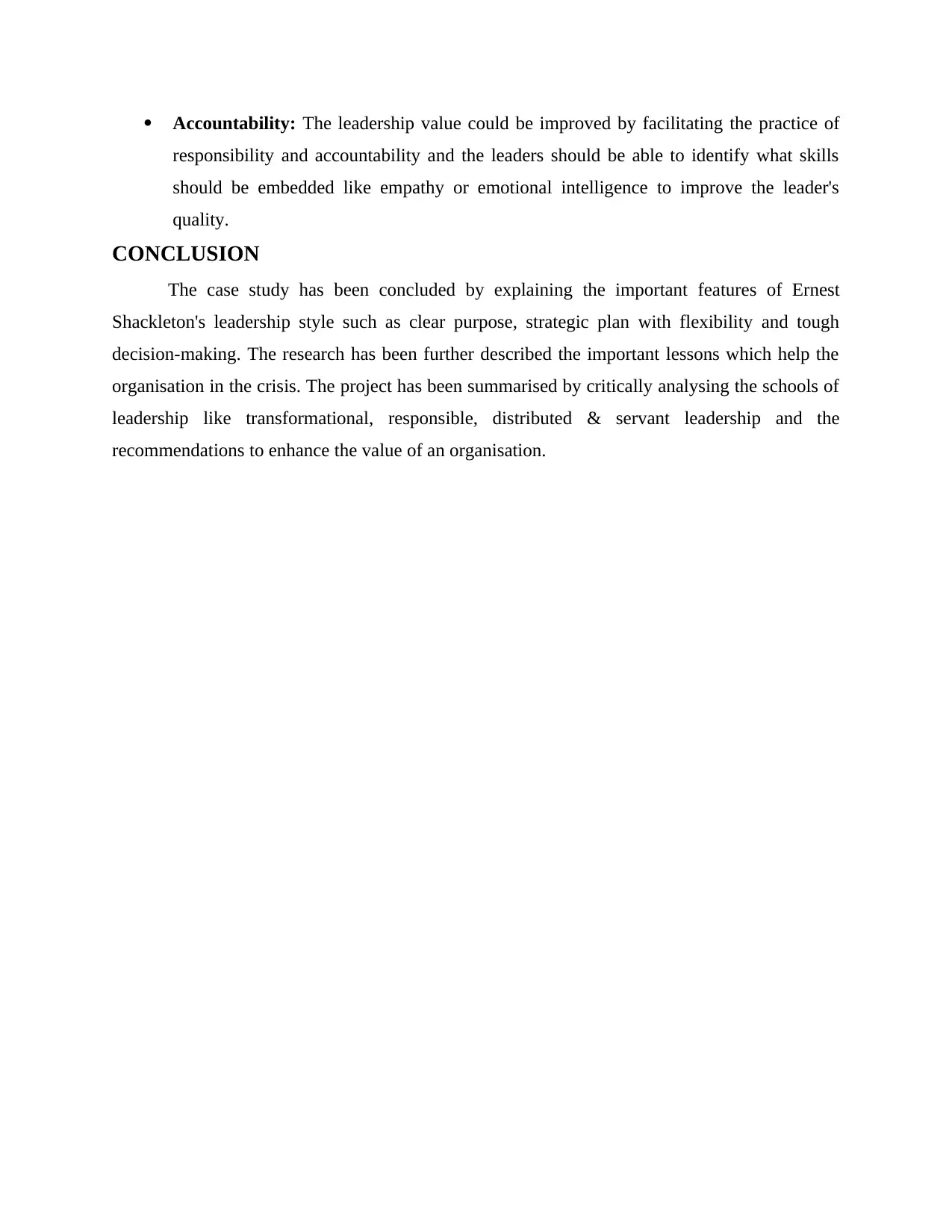
Accountability: The leadership value could be improved by facilitating the practice of
responsibility and accountability and the leaders should be able to identify what skills
should be embedded like empathy or emotional intelligence to improve the leader's
quality.
CONCLUSION
The case study has been concluded by explaining the important features of Ernest
Shackleton's leadership style such as clear purpose, strategic plan with flexibility and tough
decision-making. The research has been further described the important lessons which help the
organisation in the crisis. The project has been summarised by critically analysing the schools of
leadership like transformational, responsible, distributed & servant leadership and the
recommendations to enhance the value of an organisation.
responsibility and accountability and the leaders should be able to identify what skills
should be embedded like empathy or emotional intelligence to improve the leader's
quality.
CONCLUSION
The case study has been concluded by explaining the important features of Ernest
Shackleton's leadership style such as clear purpose, strategic plan with flexibility and tough
decision-making. The research has been further described the important lessons which help the
organisation in the crisis. The project has been summarised by critically analysing the schools of
leadership like transformational, responsible, distributed & servant leadership and the
recommendations to enhance the value of an organisation.
Paraphrase This Document
Need a fresh take? Get an instant paraphrase of this document with our AI Paraphraser
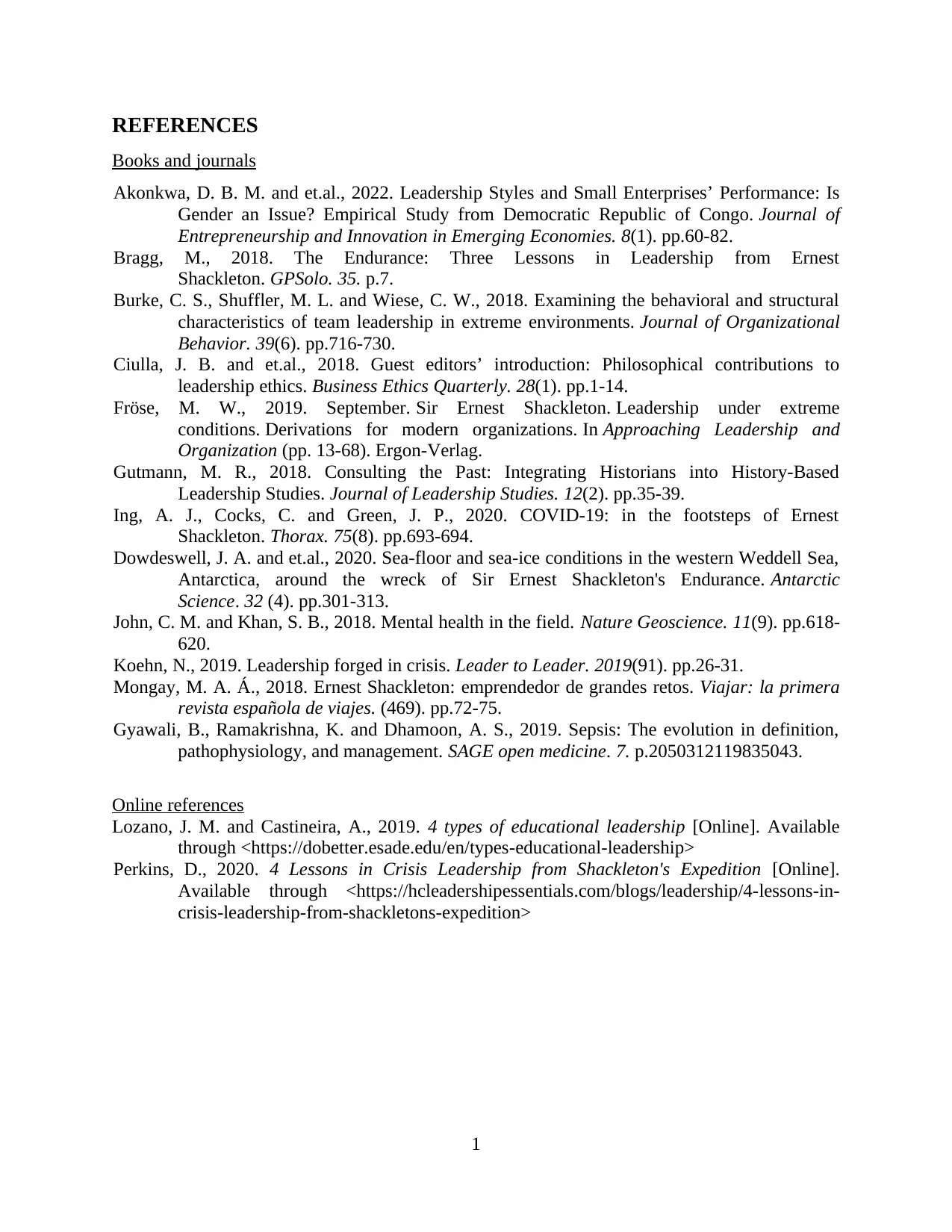
REFERENCES
Books and journals
Akonkwa, D. B. M. and et.al., 2022. Leadership Styles and Small Enterprises’ Performance: Is
Gender an Issue? Empirical Study from Democratic Republic of Congo. Journal of
Entrepreneurship and Innovation in Emerging Economies. 8(1). pp.60-82.
Bragg, M., 2018. The Endurance: Three Lessons in Leadership from Ernest
Shackleton. GPSolo. 35. p.7.
Burke, C. S., Shuffler, M. L. and Wiese, C. W., 2018. Examining the behavioral and structural
characteristics of team leadership in extreme environments. Journal of Organizational
Behavior. 39(6). pp.716-730.
Ciulla, J. B. and et.al., 2018. Guest editors’ introduction: Philosophical contributions to
leadership ethics. Business Ethics Quarterly. 28(1). pp.1-14.
Fröse, M. W., 2019. September. Sir Ernest Shackleton. Leadership under extreme
conditions. Derivations for modern organizations. In Approaching Leadership and
Organization (pp. 13-68). Ergon-Verlag.
Gutmann, M. R., 2018. Consulting the Past: Integrating Historians into History‐Based
Leadership Studies. Journal of Leadership Studies. 12(2). pp.35-39.
Ing, A. J., Cocks, C. and Green, J. P., 2020. COVID-19: in the footsteps of Ernest
Shackleton. Thorax. 75(8). pp.693-694.
Dowdeswell, J. A. and et.al., 2020. Sea-floor and sea-ice conditions in the western Weddell Sea,
Antarctica, around the wreck of Sir Ernest Shackleton's Endurance. Antarctic
Science. 32 (4). pp.301-313.
John, C. M. and Khan, S. B., 2018. Mental health in the field. Nature Geoscience. 11(9). pp.618-
620.
Koehn, N., 2019. Leadership forged in crisis. Leader to Leader. 2019(91). pp.26-31.
Mongay, M. A. Á., 2018. Ernest Shackleton: emprendedor de grandes retos. Viajar: la primera
revista española de viajes. (469). pp.72-75.
Gyawali, B., Ramakrishna, K. and Dhamoon, A. S., 2019. Sepsis: The evolution in definition,
pathophysiology, and management. SAGE open medicine. 7. p.2050312119835043.
Online references
Lozano, J. M. and Castineira, A., 2019. 4 types of educational leadership [Online]. Available
through <https://dobetter.esade.edu/en/types-educational-leadership>
Perkins, D., 2020. 4 Lessons in Crisis Leadership from Shackleton's Expedition [Online].
Available through <https://hcleadershipessentials.com/blogs/leadership/4-lessons-in-
crisis-leadership-from-shackletons-expedition>
1
Books and journals
Akonkwa, D. B. M. and et.al., 2022. Leadership Styles and Small Enterprises’ Performance: Is
Gender an Issue? Empirical Study from Democratic Republic of Congo. Journal of
Entrepreneurship and Innovation in Emerging Economies. 8(1). pp.60-82.
Bragg, M., 2018. The Endurance: Three Lessons in Leadership from Ernest
Shackleton. GPSolo. 35. p.7.
Burke, C. S., Shuffler, M. L. and Wiese, C. W., 2018. Examining the behavioral and structural
characteristics of team leadership in extreme environments. Journal of Organizational
Behavior. 39(6). pp.716-730.
Ciulla, J. B. and et.al., 2018. Guest editors’ introduction: Philosophical contributions to
leadership ethics. Business Ethics Quarterly. 28(1). pp.1-14.
Fröse, M. W., 2019. September. Sir Ernest Shackleton. Leadership under extreme
conditions. Derivations for modern organizations. In Approaching Leadership and
Organization (pp. 13-68). Ergon-Verlag.
Gutmann, M. R., 2018. Consulting the Past: Integrating Historians into History‐Based
Leadership Studies. Journal of Leadership Studies. 12(2). pp.35-39.
Ing, A. J., Cocks, C. and Green, J. P., 2020. COVID-19: in the footsteps of Ernest
Shackleton. Thorax. 75(8). pp.693-694.
Dowdeswell, J. A. and et.al., 2020. Sea-floor and sea-ice conditions in the western Weddell Sea,
Antarctica, around the wreck of Sir Ernest Shackleton's Endurance. Antarctic
Science. 32 (4). pp.301-313.
John, C. M. and Khan, S. B., 2018. Mental health in the field. Nature Geoscience. 11(9). pp.618-
620.
Koehn, N., 2019. Leadership forged in crisis. Leader to Leader. 2019(91). pp.26-31.
Mongay, M. A. Á., 2018. Ernest Shackleton: emprendedor de grandes retos. Viajar: la primera
revista española de viajes. (469). pp.72-75.
Gyawali, B., Ramakrishna, K. and Dhamoon, A. S., 2019. Sepsis: The evolution in definition,
pathophysiology, and management. SAGE open medicine. 7. p.2050312119835043.
Online references
Lozano, J. M. and Castineira, A., 2019. 4 types of educational leadership [Online]. Available
through <https://dobetter.esade.edu/en/types-educational-leadership>
Perkins, D., 2020. 4 Lessons in Crisis Leadership from Shackleton's Expedition [Online].
Available through <https://hcleadershipessentials.com/blogs/leadership/4-lessons-in-
crisis-leadership-from-shackletons-expedition>
1
1 out of 8
Related Documents
Your All-in-One AI-Powered Toolkit for Academic Success.
+13062052269
info@desklib.com
Available 24*7 on WhatsApp / Email
![[object Object]](/_next/static/media/star-bottom.7253800d.svg)
Unlock your academic potential
© 2024 | Zucol Services PVT LTD | All rights reserved.

